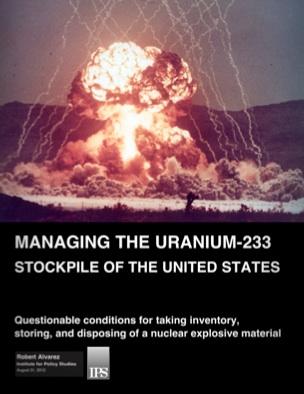
The United States has created a problem called uranium-233, a material suitable for the core of a nuclear weapon and among the most dangerous materials on the planet. If as little as 19 pounds of uranium-233 fell into the wrong hands, it could make an explosion that could destroy all of downtown Washington, D.C. or another city. As noted in The New York Times, this report documents surprising U.S. government mismanagement of the material.
Our nuclear facilities may have done a poor job of keeping track of this dangerous material. Now, the Department of Energy has indicated it plans to waive safety requirements to dispose of it. But if the U.S. government makes a mess, they should clean it up. All uranium-233 should be accounted for, stored safely, and disposed of safely.
About two tons of uranium-233, a weapon-useable fissile material, was produced by the United States, mostly in the 1960s and 1970s, as part of its military and civilian nuclear program, at an estimated cost of $5.5 billion to $11 billion. About 1.55 tons of this weapon-useable fissile material was separated, a process making it more suitable for the fission core of a nuclear weapon, before production was abandoned due to radioactive dangers in the production of this type of uranium. About 96 kilograms of uranium-233 may be unaccounted for. Specific estimates of the amount of uranium-233 in storage at certain sites widely vary, suggesting that material control and accountancy of the current U.S. inventory of uranium-233 requires greater attention.
The Energy Department has indicated it plans to waive safeguards and safety requirements to dispose of nearly 2,000 pounds of these concentrated nuclear explosive materials by simply putting them in a landfill. This would be in disregard for international safeguard and security norms as well as the department’s own nuclear security and radioactive waste disposal standards. In doing so, instead of setting an example, the U.S. government is establishing a bad precedent for the rest of the world in protecting public safety and security from concentrated fissile materials. This last remaining stockpile of uranium-233, which the U.S. Congress declared has no further use, should be properly accounted for, safely secured, and diluted for proper disposal, never to fuel nuclear weapons in the future.
The lack of priority given to this problem is underscored by the fact that the Energy Department’s “desired timeline” for disposition of this material is set for 2018, some 20 years after significant environmental, safety, and security vulnerabilities were first officially identified by the department’s Environment, Safety and Health Division of the Office of Science.
The handling of uranium-233 by the Energy Department is troubling. This report will demonstrate that the Department of Energy has yet to meet the challenges of ensuring that all uranium-233 is accounted for and that it is stored in safe facilities or safely disposed of. If these challenges are not addressed, the American people continue to face unacceptable public safety and security risks with potentially deadly consequences.